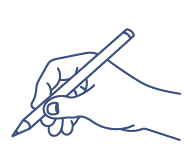How the four P checks can help your pupils master handwriting

Handwriting is a complex skill for children to learn. The physical nature of it can lead to some children taking longer to develop fine motor skills than others, making the teaching of handwriting a challenge. Problems with handwriting often stem from the physical side of writing, but these can be limited by laying secure foundations and instilling good habits early on.
To support good teaching practice, the National Handwriting Association developed the P checks to help pupils prepare to write. They identify four key areas to focus on when teaching: Posture, Pencil grip, Paper position and Pressure.
Pupils should be introduced to the P checks from Reception and continue to use them through to Year 6, with reminders becoming a regular feature of writing sessions. One way to promote the P checks is to establish a routine for pupils to follow whenever they write and to provide a visual reminder to reinforce this.
Below we’ve outlined the four P checks and explained how they support good handwriting practice. A P checks reminder sheet is available as a free download alongside several other handwriting resources on our website.
Posture
Posture plays a crucial role in children's ability to write effectively. Writing at a table requires body positioning that is dynamic and relaxed. To achieve this, children should sit back in their chair, about a fist’s width from the table, so that their back is supported. The child’s hips should be facing forward with their thighs at an approximate right angle to their backs. Both feet should be flat on the floor or supported by a wide-based footrest.
Make sure that the table is the correct height for the child. Both their forearms should rest easily on the surface of the table without them having to hunch over or sit with their shoulders hitched upwards.
You should also ensure that there is sufficient space between the children so that their movements aren't restricted – this can often be a problem when a group of children sit at a table. You should identify any left-handers and ensure that they are not sitting to the right of a right-hander. Finally, encourage children to keep their tabletops clean and free from clutter so that they have an even surface and their writing arm can move smoothly.
Pencil grip
An effective pencil grip is essential for legible and fluent handwriting. Once children are developmentally ready, they should be shown how to hold a pencil correctly. A dynamic tripod grip is the most effective, with the pencil held between the thumb and index finger while it rests on the middle finger. This grip allows the child to control the pencil to make the precise movements needed when forming letters.
Children should be encouraged to hold the pencil so that there is a space between their fingertips and the tip of the pencil (usually about 2cm for right-handers and slightly more for left-handers). This allows the children to see what they are writing. The pencil should be angled towards the shoulder.
Encourage children not to grip the pencil too tightly. A relaxed but controlled grip is needed so that their writing can flow freely. Writing should feel comfortable and sustainable.

The correct pencil grip
Paper position
The paper should be placed slightly to the side rather than directly in front of the child. It should also be tilted at a slight angle to the body (approximately 20° to 45°) so that it follows the natural movement of the hand across the page when writing. This means a right-hander should tilt the top left-hand corner downwards; a left-hander should tilt the top right-hand corner downwards.
Children should use their non-writing hand to hold the paper still. They should also use this hand to move the paper up as writing continues down the page so that the paper stays in comfortable reach. The writing hand is supported by the wrist, which should be kept stable and should rest on the table below the writing line. The fingers can then move freely without putting strain on the hand.
Pressure
Pressure through the pencil can affect the flow of writing. Pressing too hard, so that the marks go through to the next page or the paper tears, can cause discomfort and slow writing down. Pressing too lightly will result in handwriting that is too faint to be easily legible.
Children need to apply just the right amount of pressure to ensure that writing can flow along. This involves using a combination of thumb, finger and wrist movements. Children usually learn through experience how much pressure is needed. Encourage experimentation by letting children use different writing tools.
Structured practice
Handwriting is a skill that requires practice to achieve fluency. The Schofield & Sims WriteWell Pupil Books provide plenty of opportunities for children to practise at each stage of their handwriting journey. The corresponding WriteWell Teacher’s Handbook is filled with advice and guidance, including further support on introducing the P checks.
To receive a free evaluation copy from the scheme, simply call 01484 607080 or email sales@schofieldandsims.co.uk.
comments powered by Disqus